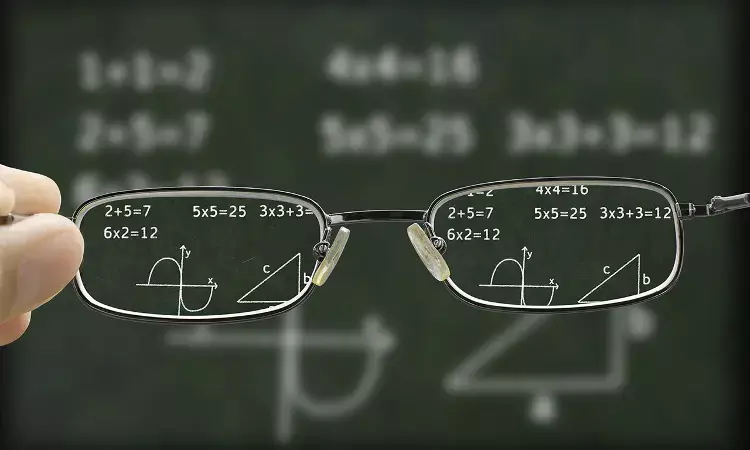- Home
- Medical news & Guidelines
- Anesthesiology
- Cardiology and CTVS
- Critical Care
- Dentistry
- Dermatology
- Diabetes and Endocrinology
- ENT
- Gastroenterology
- Medicine
- Nephrology
- Neurology
- Obstretics-Gynaecology
- Oncology
- Ophthalmology
- Orthopaedics
- Pediatrics-Neonatology
- Psychiatry
- Pulmonology
- Radiology
- Surgery
- Urology
- Laboratory Medicine
- Diet
- Nursing
- Paramedical
- Physiotherapy
- Health news
- Fact Check
- Bone Health Fact Check
- Brain Health Fact Check
- Cancer Related Fact Check
- Child Care Fact Check
- Dental and oral health fact check
- Diabetes and metabolic health fact check
- Diet and Nutrition Fact Check
- Eye and ENT Care Fact Check
- Fitness fact check
- Gut health fact check
- Heart health fact check
- Kidney health fact check
- Medical education fact check
- Men's health fact check
- Respiratory fact check
- Skin and hair care fact check
- Vaccine and Immunization fact check
- Women's health fact check
- AYUSH
- State News
- Andaman and Nicobar Islands
- Andhra Pradesh
- Arunachal Pradesh
- Assam
- Bihar
- Chandigarh
- Chattisgarh
- Dadra and Nagar Haveli
- Daman and Diu
- Delhi
- Goa
- Gujarat
- Haryana
- Himachal Pradesh
- Jammu & Kashmir
- Jharkhand
- Karnataka
- Kerala
- Ladakh
- Lakshadweep
- Madhya Pradesh
- Maharashtra
- Manipur
- Meghalaya
- Mizoram
- Nagaland
- Odisha
- Puducherry
- Punjab
- Rajasthan
- Sikkim
- Tamil Nadu
- Telangana
- Tripura
- Uttar Pradesh
- Uttrakhand
- West Bengal
- Medical Education
- Industry
Highly aspherical lenslets slow progression of myopia, finds study

VIETNAM: According to research published in the American Journal of Ophthalmology, highly aspherical lenslets spectacle lenses were beneficial in reducing myopia, and the findings did not indicate a resurgence of myopia after withdrawal.
Myopia is a significant problem, estimated to afflict nearly half of the world's population by the year 2050. Any degree of myopia has been shown to increase the likelihood of problems.
Recent lens designs with numerous lens segments and aspherical lenslets in the mid-peripheral to peripheral section of the lens showed good efficacy in randomised clinical studies as compared to the control single vision spectacle group among spectacle lenses intended to slow myopia.
The authors conducted a short-term, prospective, double-blind, randomised, clinical trial involving cross-over of the interventions in order to determine the effectiveness of spectacle lenses with highly aspherical lenslets in slowing the progression of myopia compared to single vision spectacle lenses.
119 Vietnamese children aged 7 to 13 with spherical equivalent refractive error (SE) of -0.75 to -4.75D were randomly assigned to wear either HAL or SV, and after 6 months (Stage 1) switched to the other lens for an additional 6 months (Stage 2). After stage 2, both groups continued to wear HAL for an additional six months. Group 1 was referred as as HSH (HAL-SV-HAL) and Group 2 as SHH, based on the order in which lenses were worn at each stage (SV-HAL-HAL).
The key results included a comparison of SE and axial length (AL) between HAL and SV for each stage, as well as a comparison of SE and AL with SV between the HSH and SHH groups to see if myopia recovered after switching from HAL to SV (HSH group).
Major highlights of the study:
- In stages 1 and 2, myopia developed more slowly with HAL than SV (SEΔ stage 1: -0.21 vs -0.27D, p=0.317; ALΔ stage 1: 0.07 vs 0.14mm, p=0.004; stage 2: 0.04 vs 0.17mm, p=0.001).
- Between the HSH and SHH groups, there were no differences in Δ SE/AL with SV (Δ SE: -0.330.27D vs. -0.270.42D; Δ AL: 0.170.13mm vs. 0.130.15mm; p=0.092).
- With both lenses, an average of 14 hours per day of lens usage was noted.
The researchers came to the conclusion that highly aspherical lenslets slows myopia in this cross-over trial based on comparisons between groups and within groups.
Children complied with lens wear requirements, and results when switching from HAL to SV did not indicate rebound.
REFERENCE
Sankaridurg P, Weng R, Tran H, Spiegel DP, Drobe B, Ha T, Tran YH, Naduvilath T. Spectacle lenses with highly aspherical lenslets for slowing myopia: A randomised, double-blind, cross-over clinical trial. Am J Ophthalmol. 2022 Nov 5:S0002-9394(22)00418-4. doi: 10.1016/j.ajo.2022.10.021. Epub ahead of print. PMID: 36347276.
Dr Kamal Kant Kohli-MBBS, DTCD- a chest specialist with more than 30 years of practice and a flair for writing clinical articles, Dr Kamal Kant Kohli joined Medical Dialogues as a Chief Editor of Medical News. Besides writing articles, as an editor, he proofreads and verifies all the medical content published on Medical Dialogues including those coming from journals, studies,medical conferences,guidelines etc. Email: drkohli@medicaldialogues.in. Contact no. 011-43720751


